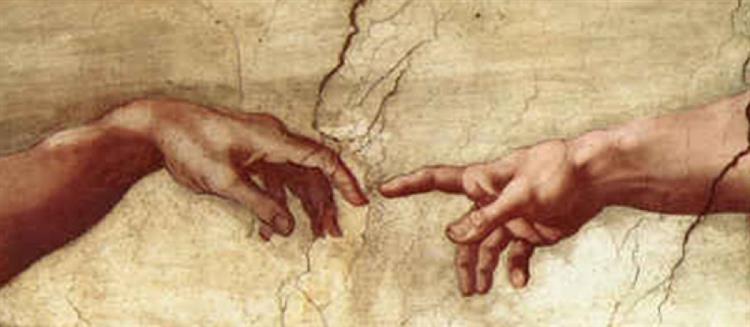The Sistine Chapel’s ceiling features a fresco work by Italian artist Michelangelo called The Creation of Adam, which was created somewhere between 1508 and 1512.
It serves as an illustration of the Genesis creation story, in which God creates Adam and gives him life. The fresco, which is the fourth in a chronological series of panels illustrating Genesis incidents, is a component of a sophisticated iconographic design.

Humanity has come to associate itself with the picture of God and Adam’s nearly touching hands. The painting has been copied in many imitations and parodies. One of the most reproduced religious works of art ever is Michelangelo’s Creation of Adam.
The freshly elected Pope Julius II sent an invitation to Michelangelo to return to Rome in 1505. He was given the job of constructing the Pope’s tomb, which had to be done in five years and contain forty statues.
Michelangelo’s work on the tomb was frequently put on hold while working for the Pope in order to complete a variety of other responsibilities. Despite spending 40 years working on the tomb, Michelangelo was never satisfied with how it turned out.
It was completed in 1516 and is housed in the Church of S. Pietro in Vincoli in Rome. It is most well-known for its central Moses figure. The Rebellious Slave and the Dying Slave are two of the other statues that were destined for the tomb and are currently on display at the Louvre.
The Sistine Chapel’s ceiling was painted by Michelangelo over the same time period, and it took him about four years to finish (1508–1512). Condivi claims that Bramante, who was engaged on the construction of St. Peter’s Basilica, resented Michelangelo’s commission for the Pope’s tomb and persuaded the Pope to commission him in a medium he was unfamiliar with in so that he may fail at the task.
Originally, Michelangelo was hired to decorate the center of the ceiling and paint the Twelve Apostles on the triangular pendentives that supported it.
A different and more intricate plan, illustrating the Creation, the Fall of Man, the Promise of Salvation through the prophets, and the lineage of Christ, was offered by Michelangelo after persuading Pope Julius to grant him free reign. The piece is a part of a bigger design plan for the chapel that represents much of the Catholic Church’s teaching.
Over 300 figurines are included in the over 500 square meters of the composition’s ceiling surface. Three groups of nine Genesis stories—God creating the earth, God creating humanity and their fall from grace, and finally the state of humanity as symbolized by Noah and his family—are at the book’s center.
Twelve people, including five Sibyls, who were classical prophetic women, and seven Israelite prophets who foretold the arrival of Jesus, are depicted on the pendentives that support the ceiling. The Creation of Adam, Adam and Eve in the Garden of Eden, the Deluge, the Prophet Jeremiah, and the Cumaean Sibyl are some of the most well-known ceiling paintings.











